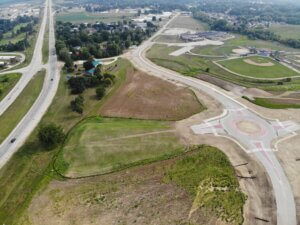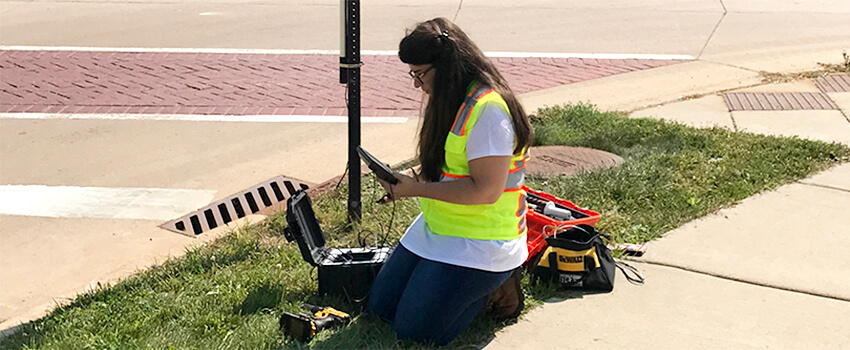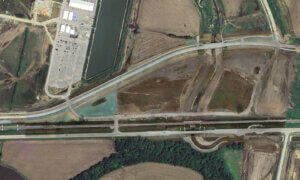

Traffic Video Camera Installation - Main Street, Sun Prairie, WI
Traffic Safety Studies
Traffic Safety Studies: Exploring Operational Concerns to Determine Solutions
Traffic and safety studies evaluate transportation system concerns and determine appropriate solutions. Through data collection and analyses, specific operational or safety issues are examined to determine their causes or forecast impacts. Possible improvement measures are then identified and explored. Applying sound engineering judgment and experience, recommended improvements are determined with careful consideration of the benefits, costs, and impacts.
Existing Concerns & Proposed Development: Two Reasons Why a Traffic Study Can Help
If your community has expressed concerns about current traffic operations or safety, a study can be highly beneficial to identify the issue at hand and the solutions available to correct it. Increased traffic congestion and severe crashes, such as those observed near the E. 1st Street Interchange in Ankeny, Iowa, are two reasons why your community may want to explore having a study done.
Traffic and safety studies can also provide important insight into how traffic circulation and patterns may change as the result of new development. In this instance, traffic and safety study results will guide a proactive approach to ensure a smooth flow of traffic. Recommended improvements may include additional lanes, traffic controls, or roundabouts, like those initiated by a traffic impact study for the Outlets of Des Moines.
What to Expect from Traffic Safety Studies
We tailor our approach to traffic and safety studies to address specific client needs and the facilities under study. Through data and modeling, we’ll work to illustrate the issues at hand and the results that could be expected by applying alternative solutions. Different times of day and traffic impacts will be taken into account to test the performance of each alternative. We’ll also look ahead, taking future traffic predictions into account to provide long-term peace of mind.
Typical tasks a study may include are:
- Data collection/traffic counts
- Crash history/predictive analysis
- Traffic forecasting
- Traffic operations analysis/modeling
- Traffic signal warrant analysis
- Traffic & safety recommendations
- Functional lane design
- Cost opinions
- Benefit/cost analysis
- Potential funding sources
- Public involvement
- Report preparation
The results of the study and analysis, as well as proposed recommendations, will be provided in a thorough report. Our goal is to provide you with a tool that guides decision-making to maximize the benefit of improvements to your transportation network. These detailed reports can also be used to support applications for project funding, the development of capital improvement programs, or cost-sharing approaches.
Snyder & Associates Traffic Safety Services
Safety Studies
Reducing crashes and injuries on our streets and highways is a top priority. Safety studies help to do this by examining crash history, existing geometry, and traffic control and identifying effective countermeasures. Study scopes may be rather broad (statewide) or focused on a specific location or corridor.
Interchange Studies
Proposed new or modified interchanges on interstate highways require an Interchange Justification Report (IJR) or an Interchange Operations Report (IOR). Specific federal and state guidelines must be followed to ensure that proposed changes won’t negatively impact traffic operations or safety. For interchanges on a state or U.S. highway, an IOR is typically required.
Corridor Studies
Corridor congestion, safety concerns, planned improvements, or land development often suggest the need for a corridor study. A corridor study considers traffic operations and intersection safety to determine corridor and intersection improvements through a comprehensive approach. Options to improve operations and safety may include coordinated signal systems, roundabouts, road diets, or improved pedestrian and bicycle facilities.
Intersection Studies
Traffic operations, safety, traffic signal operation, roundabout concepts, and pedestrian/bicycle accommodation are elements often included in an intersection study. Studies are typically performed to determine intersection improvement needs or recommended lane configurations for a planned reconstruction or new intersections.
Access Studies
Properly balancing mobility and access needs is the goal of access studies. Recommended access locations, spacing, and geometry determinations are based on specific characteristics of land use, roadway, traffic, and the site.
Traffic Impact Studies
Cities, counties, and state DOTs often require a traffic impact study or analysis (TIS/TIA) to evaluate traffic and safety impacts associated with a proposed development. The TIS/TIA determines the intersection and traffic control improvements needed to accommodate additional traffic generated by the development site.
School Studies
Providing safe and efficient traffic operations for vehicles, pedestrians, and bicycles at and near schools is the goal of a school study. School areas have unique vehicular and pedestrian traffic characteristics that must be considered. Studies may include operational and safety analysis, school crossings, walking/biking routes, bus access, internal site circulation, and parent drop-off/ pick-up operations.
Bicycle & Pedestrian Studies
Pedestrians and bicyclists are the most vulnerable users of our transportation systems, so providing for their safety is vitally important. Multimodal facilities enhance community livability and support healthy lifestyles by supporting active recreation and reducing traffic congestion. Bicycle and pedestrian studies identify and evaluate multimodal accommodations including sidewalks, trails, shared-use paths, bike lanes, crossings, and traffic control improvements.

